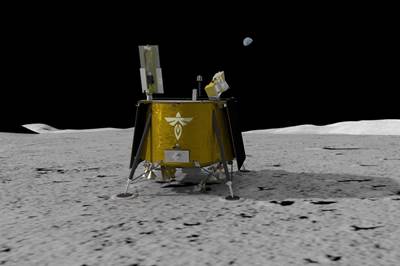Firefly awarded $179 million NASA contract for moon delivery
Company’s third lunar mission and fourth NASA CLPS task order uses Firefly’s carbon fiber Blue Ghost lunar lander, Elytra Dark orbital vehicle and a rover to operate six NASA instruments.
Share
Rendering of Firefly’s Elytra Dark orbital vehicle deploying Firefly’s Blue Ghost lander into lunar orbit. Source | Firefly Aerospace
In mid-December 2024 Firefly Aerospace Inc. (Cedar Park, Texas, U.S.) was awarded an approximately $179.6 million NASA (Washington, D.C., U.S.) contract to deliver and operate six NASA instruments in the Gruithuisen Domes on the moon’s near side in 2028. As part of NASA’s Commercial Lunar Payload (CLPS) initiative, the mission will use Firefly’s Blue Ghost lunar lander, Elytra Dark orbital vehicle and a rover from an industry provider to investigate the composition of the Gruithuisen Domes — a part of the moon that has never been explored.
“Firefly is proud to land our fourth NASA CLPS award for another complex mission, which is what our team does best,” says Jason Kim, CEO of Firefly Aerospace. “This team gained a hard-earned reputation for smooth payload integrations, well-rehearsed operations, and robust testing and transparency throughout Blue Ghost Mission 1 preparations. Firefly works toward becoming the go-to commercial company to provide autonomous systems on the moon and beyond.”
During mission operations, Firefly’s Elytra Dark transfer vehicle will first deploy the Blue Ghost lander into lunar orbit and then remain on orbit to provide long-haul communications. Blue Ghost will then land in the Gruithuisen Domes, deploy the rover and support payload operations for more than 14 days on the lunar surface. NASA payloads onboard Blue Ghost include the Radio-wave Observations at the Lunar Surface of the photoElectron Sheath (ROLSES) telescope, the Sample Acquisition, Morphology Filtering, and Probing of Lunar Regolith (SAMPLR) robotic arm, the Neutron Measurements at the Lunar Surface (NMLS) instrument, the Photovoltaic Investigation on the Lunar Surface (PILS) instrument and the Heimdall camera system.
The mission will also carry NASA’s Lunar Vulkan Imaging and Spectroscopy Explorer (Lunar-VISE) payload with multiple instruments attached to both the lander and rover to determine the composition of the Gruithuisen Gamma Dome. Considered a geologic mystery, the Gruithuisen Domes appear to be composed of silica-rich volcanic minerals, which could indicate the presence of lunar water and hydrogen. The NASA payloads onboard Blue Ghost Mission 3 will investigate the formation and physical properties of the domes, including the potential detection of water and hydrogen molecules, in addition to other science investigations.
“Firefly is dedicated to flying annual missions to the moon for government and commercial customers as we continue to pave the way for a lasting lunar presence,” says Brett Alexander, chief revenue officer at Firefly Aerospace. “We’re seeing growing interest from organizations looking to unlock the moon’s resources and build a robust lunar ecosystem, and we welcome additional partners to join us.”
Along with the NASA payloads, Firefly’s mission has capacity for additional customers, offering orbital transfer and long-haul communications in cislunar space on Elytra as well as lunar surface delivery and operations on Blue Ghost. Customers interested in joining Blue Ghost Mission 3 can find more information here.
Firefly’s first mission to the moon, Ghost Riders in the Sky, is on track for launch in mid-January 2025 with 10 NASA payloads onboard Blue Ghost. Firefly’s second lunar mission is scheduled to launch in 2026, using a similar two-stage spacecraft configuration as Blue Ghost Mission 3, with the Blue Ghost lander stacked on Elytra Dark to support payload operations on the far side of the moon and in lunar orbit.
Related Content
New GTL breakthrough in composite tubing for liquid hydrogen in aircraft and space vehicles
Tests versus stainless steel tubing show 10 times faster chill down, fuel flow in 2 seconds and less boil-off for significantly faster fueling and refueling of LH2-powered space vehicles, aircraft and trucks.
Read MoreHigh-temperature composite 3D printing facilitates design, manufacture of deployable space structures
Opterus R&D employs an AON3D printer and OOA prepregs to build the tooling, prototypes and end-use versions of its foldable CFRP satellite structures.
Read MoreA new era for ceramic matrix composites
CMC is expanding, with new fiber production in Europe, faster processes and higher temperature materials enabling applications for industry, hypersonics and New Space.
Read MoreOn the radar: Reusable launch vehicles, hypersonics make space more accessible
CFRP has become key to targeting efforts in reusing components like rocket stages, as well as the development of reusable hypersonic testbeds and spaceplanes, for increasing space commercialization.
Read MoreRead Next
Composites-intensive Perseverance rover makes Jezero Crater milestone
Since its landing on Mars in 2021, NASA’s rover has completed four scientific campaigns. Its fifth campaign up to the crater rim, a location of geologic interest, will further aid scientists’ understanding of Mars’ past formation.
Read MoreVirgin Galactic, ENAC to conduct spaceport feasibility study
Agreement with Italy’s civil aviation authority to determine the conditions for suborbital operations from the Grottaglie Spaceport, inspired by Virgin’s model in the U.S. with the composites-intensive VSS Unity.
Read MoreNASA selects Firefly Aerospace for Artemis commercial moon delivery in 2023
Part of NASA's Commercial Lunar Payload Services (CLPS) initiative, Firefly’s Blue Ghost lander will deliver 10 technology payloads to the moon.
Read More















